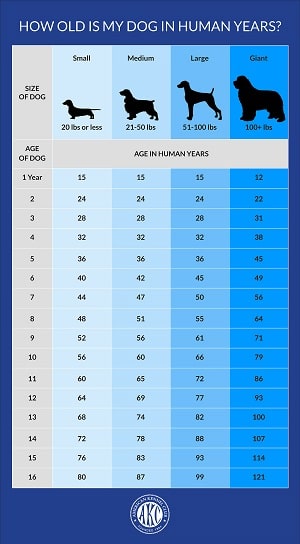For roughly 60 years, veterinarians have suggested that dogs age seven years to our every one year. Is this true or a myth? Certainly, dogs age faster than humans, so what’s the deal? Researchers agree that dogs do age faster than us, but at a different rate than has long been believed. In order to better understand the mechanisms of aging, scientists recently studied specific genetic differences between dogs and humans. The study led to a new formula that calculates a more accurate ‘age’ for dogs.
All mammals go through an aging process; life stages that include birth, infancy, youth, adolescence, adulthood, and seniority. However, mammals go through the process at different rates. Researchers are aiming to understand how a dog ages to help with longevity and quality of life. Likewise, knowing how our dogs age in comparison to us, scientists can work to translate the data to other species.
“Dogs experience the same biological hallmarks of aging as humans, but do so in a compressed period, around 10 to 15 years on average, versus over 70 years in humans. This makes dogs invaluable for studying the genetics of aging across mammals, including humans,” said Elaine Ostrander, Ph.D., National Institute of Health Distinguished Investigator, as well as co-author of the study.

Photo Courtesy: Pexels
Scientists from the National Human Genome Research Institute, collaborating with the University of California at San Diego and Davis, and the University of Pittsburgh School of Medicine, compared age progression between dogs and humans using epigenetics – biological markers for the aging process. Evidence has shown that changes in epigenetics are connected to certain stages of aging, and these markers are seen among species. For example, the first eight weeks of a puppy are comparable to the first nine months of an infant human.
“In terms of how physiologically mature a 1-year-old dog is, a 9-month-old dog can have puppies. Right away, you know that if you do the math, you don’t just times seven,” said senior author, Trey Ideker, according to Science Daily. “What’s surprising is exactly how old that one-year-old dog is — it’s like a 30-year old human.”

Photo Courtesy: Pexels
The study used blood from 104 Labrador retrievers, ranging in age from 4 weeks to 16 years old. Researchers focused on the process of methylation – when methyl groups attach to DNA, subsequently turning the gene off. These methylation patterns change in conjunction with aging, a process that accurately measures human years but doesn’t translate over to other species.
Researchers took previous methylation patterns from 320 people, ranging in age from 1 year to 103 years old to compare the data with the Labrador retrievers. Scientists found similar patterns, especially with the data of young dogs and young humans, and older dogs and older humans. As a result and based on a human epigenetic clock, researchers came up with a new formula to determine the age of a dog in human years.
Because the study focused on mostly Labrador retrievers, Dr. Ostrander noted, “It will be particularly interesting to study long-lived breeds, a disproportionate number of which are small in size, versus breeds with a shorter lifespan, which includes many larger breeds. This will help us correlate the well-recognized relationship between skeletal size and lifespan in dogs.”

Photo Courtesy: Pexels
Smaller dogs tend to live longer than larger dogs, but it’s not clear why. Experts speculate that body mass is directly associated with a dog’s lifespan, but research hasn’t yet made that connection. Scientists have discovered that for every 4.4 pounds of body mass, a dog’s life expectancy decreases by about one month. Why is unknown.
The American Kennel Club has done the math for dog owners, and its website features a “How Old Is My Dog In Human Years?” chart. Broken down into four columns to encompass breeds from small to giant, the chart lists out the comparable human age of a dog’s age based on a weight range. The larger and heavier the breed, the shorter the life span.

Image Courtesy: American Kennel Club
For example, a 12 year old dog who weighs less than 20 pounds is at a comparable stage in the aging process as a 64 year old human. However, a giant breed that weighs more than 100 pounds at 12 years old is at a comparable stage on the aging spectrum as a 93 year old human.
Another example includes the age of seniority, which differs for dogs of different sizes. For a dog less than 20 pounds, seniority is around the age of 11 or 12 years. For a dog weighing around 100 pounds, seniority is considered 8 or 9 years old.
While many dog lovers may find this news disheartening, the good news is that pet parents can play a significant role in improving their four-legged friends’ quality of life and longevity. Much like humans can live longer, healthier lives by making healthy diet and lifestyle choices, you can help your dog feel younger and remain active long into their senior years by keeping up with routine veterinary care, feeding them a high quality diet, and ensuring they get regular exercise.
Featured Photo Courtesy: Pexels







